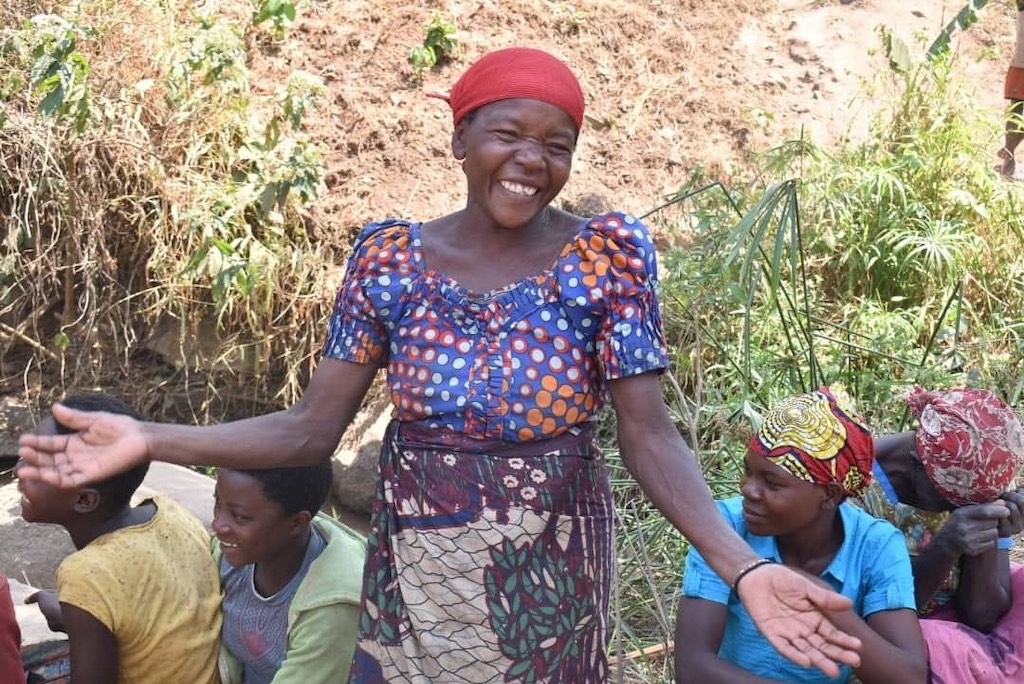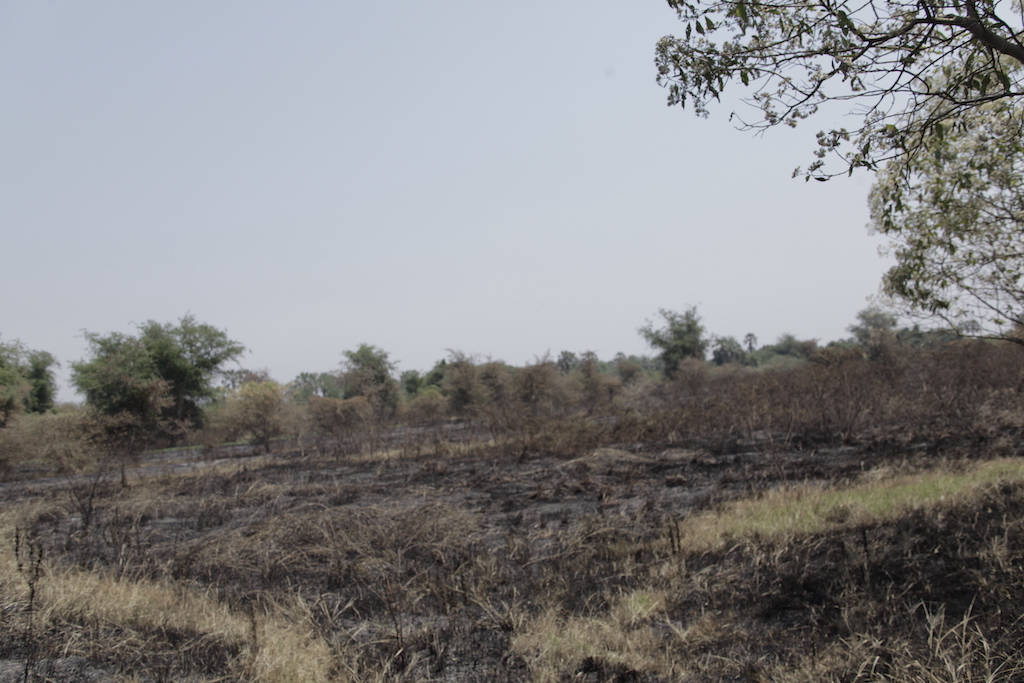
17 Aug A burning issue for Burundi’s reserves
Bushfires in Burundi’s protected areas are prohibited by law, but runaway infernos are threatening the reserves and contributing to climate change. Espoir Iradukunda investigates

A farm wiped out by a runaway fire. About 1,000ha are burnt to ashes nationwide each year due to wildfires. Photo: Espoir Iradukunda
From the end of June to the beginning of September each year, wildfires occur nationwide in Burundi’s wildlife reserves, caused by farmers who use rudimentary agricultural methods and livestock breeders who need green pastures.
The flames last around 16 weeks and have destructive consequences on the ecosystem, according to environmentalists. In Burundi, bushfires are prohibited within the boundaries of protected areas.
“Approximately 1,000 hectares are burnt to ashes nationwide each year due to runaway bushfires in reserves and forests,” said Léonidas Nzigiyimpa, legal representative of Conservation and Community of Change-3C and a former director of the Burundi Environment Protection Authority (OBPE). “It’s a worrying phenomenon because the devastation caused by these bushfires is extremely widespread and harmful.”
While the fires mainly destroy grasslands, some tree cover is lost as well. According to Global Forest Watch, from 2001 to 2021 Burundi lost 17ha of tree cover from fires and 31.8ha from all other drivers of loss.
Management tool
Nzigiyimpa said slow-burning fires in April and May are used as a management tool for the natural ecosystems in protected areas. They help to control forest canopy and create pastures for grazing wildlife living in protected areas such as the Ruvubu National Park. It’s the late fires that occur from June to October that must be avoided because they are violent and destructive, he said.
Claver Sibomana, lecturer and researcher at the National University of Burundi in the faculty of science, said biodiversity is lost as a result of these late fires. The soil is denuded, leading to erosion. And there is the disappearance of trees that serve as carbon sinks and water towers.
“Almost all the protected areas in Burundi are water reservoirs. When you light late fires, the vegetation cover is erased. As a result, during the rainy season, the water is no longer retained and does not infiltrate into the shallows,” Sibomana said.
“The other consequence is that when greenhouse gases, particularly carbon dioxide, are released back into the atmosphere, you are contributing to the worsening of the harmful effects of climate change,” added Sibomana.

A family coming from Parc National de la Kibira in Kayanza with firewood. Photo: Arthur Bizimana
Climate change
Nzigidahera Bénoît, an environmental consultant who conducted research on vulnerability and adaptation to climate change in Burundi, said the management fires implemented in the wet season between April and May include firebreaks.
“These are paths that we clean up. They vary in width from three to six metres. The taller the grass, the wider the firebreaks have to be. When there are bushfires, the flames won’t jump these spaces. This is an ancient technique, even used around artificial woodland,” he said.
Advanced techniques, mostly practised by specialists, include setting fire to a 100m strip and extinguishing it. If criminals set a fire and the flames reach this strip, the fire will stop. It’s a way of putting out fire with fire, of getting ahead of accidental fires.
“Other, more sophisticated techniques use new information and communication technologies for surveillance. With remote sensing and satellites, fires can be monitored from a distance, from an office or a base. Unfortunately, Burundi does not have this technology,” Bénoît said.

A burnt section in the northern part of Rukoko reserve in Bubanza after it caught fire in July. Photo: Arthur Bizimana
Widespread impunity
Burundi’s Forestry Code, established in 1984 and amended in 2016, aims to prevent the destruction of forests by bushfires. It provides for fines of up to BIF2-million (about US$700) and prison sentences of up to five years.
However, the enforcement of these laws is problematic. Nzigiyimpa testifies that he has seen cases of people who were apprehended for burning a nature reserve who were quickly released.
Experts, advocates and scientists agree on the lack of proper resources to protect the various reserves.
“The officers in charge of protecting protected areas are not sufficiently equipped. They are barefoot. They can’t intervene quickly,” said Kazungu Pierre, representative of the hub of cooperatives to protect reserves in Bururi. “They have no means of transport or communication. They don’t have any fire-extinguishing equipment, even though there is appropriate equipment for this kind of activity.”
Added to this is the lack of a bushfire monitoring centre, as is customary in other countries, he said.

Marthe Nyinawabo, one of the community monitors who have been capacitated to alert authorities when bushfires break into Vyanda, Rumonge province. Photo: Arthur Bizimana
Monitoring and prevention
Jean Marie Sabushimike, a lecturer at the National University and environmentalist, said new information and communication technologies are now being used to help combat bushfires through monitoring and prevention.
“Sadly, in Burundi there is no technology that allows us to detect fires at any time using satellite images to monitor the whole country. When we talk about the size and recurrence of these bushfires, we see that the figures do not reflect reality,” said Sabushimike.
Protected area agents do not have the means to go to the scene of the fire to record the data. Very few forestry officers have a GPS (Global Positioning System).
“There are no environmental police,” said Nzigiyimpa. “At one point an environmental police force was set up, but was later abolished. The OBPE uses on-the-ground trained forest guards and eco-guards. They are not organised as they are in other countries.”
In other countries, Nzigiyimpa pointed out, “the water and forestry services are called paramilitaries or corps habillés. Compared to our forest wardens, these are people who are better equipped, who have paramilitary training to meet the challenges of protecting biodiversity in terms of flora and fauna.
“In our country, these are people who are not equipped and who work like other civil servants. Environmental crimes that occur in these areas can be committed at any time, and they don't have the means to deal with them. In terms of numbers, there are fewer of them, and in terms of quality, they don’t have enough skills.”
Nzigiyimpa suggested improving the living conditions of the local population is very important in conservation activities, because one of the causes of the destruction of natural resources is poverty.
“The old forestry code states that when someone is caught burning a woodland area of 1ha, the fine goes up to BIF10,000 [about US$3,5],” said Emmanuel Ndorimana, Permanent Secretary at the Ministry of the Environment and of Livestock. A small sum, according to him, compared to the consequences caused by bushfires.
For him, “lighting bushfires means making communities suffer”. Agriculture and livestock farming are badly affected. He also mentioned desertification, the direct consequences of which are the destruction of biodiversity and famine.

An oven inside Ruvubu reserve in the east of Burundi where charcoal has been one of the lucrative businesses that have caused wildfires in recent years. Photo: Arthur Bizimana
Apply the law
The solution, according to Albert Mbonerane, former Burundian minister for the environment, and current president of Ceinture Verte, a local environmental protection organisation, is to apply the law and punish offenders effectively.
He said the ministry of environmental protection must provide substantial resources (men, vehicles, aircraft, helicopters) to support the local fire brigade. The system must then be complemented by preventive measures and surveillance of the mountain ranges, as well as increased vigilance on the part of the forces of law and order.
Sabushimike added that protected areas are there to preserve biodiversity and the various ecosystem services, and to support tourism. “Ecotourism is centred on the discovery of ecosystems and involves the active participation of local populations and tourists in safeguarding biodiversity – in short, ensuring protected areas are there for the people,” he said.
Espoir Iradukunda is managing editor of Inside Burundi. This investigation was supported by InfoNile, in collaboration with the Oxpeckers #WildEye Eastern Africa project, with funding from Earth Journalism Network's Biodiversity Media Initiative
You can follow these and other environmental crime incidents in the region on our #WildEye Eastern Africa mapping tool
